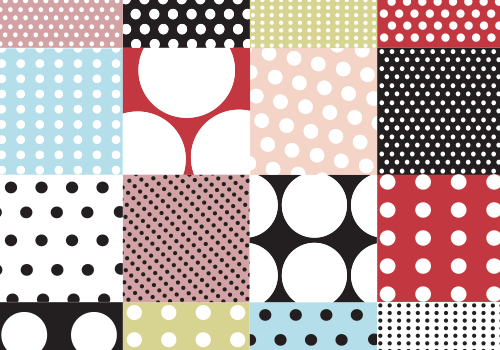
In Medieval Europe, polka dots were initially seen as very unpleasant, representing disease and impurity. Back in those days, there was no technology to create uniformly spaced polka dots. They were unevenly spaced on fabric, which reminded people of rashes that were caused due to many contagious and deadly diseases like Small pox, Bubonic plague and leprosy, which were rampant at that time. This unpleasant association continued throughout the period of Renaissance.
Dotted fabrics in Europe had many different names before they were called polka dots. Raised dots on tulle were called Dotted-Swiss, the French had quinconce for the dots, and the German called it Thalertupfen. In Spanish, dots are lunares, or “little moons”.
In the mid 19th century, a polka dance craze swept through the whole of Europe, which is where the modern term “Polka Dot” comes from. While it isn’t really clear how the dance and pattern is connected, it is believed that the pattern stands for the cheerful, light nature of the dance. Europeans were absolutely crazy about the polka. Polka-themed products started coming in the market in the form of polka hat and polka jacket.
In the 1940s, there was resurgence in the popularity of the polka dance. With the return of the dance came a comeback of the dotted pattern.
It was singer Frank Sinatra’s first hit, the 1940 ballad “Polka Dots and Moonbeams” which captured the polka dot trend of that era. The Los Angeles Times recommended its readers to invest in the polka dot trend for the 1940 spring season.
Polka dot clothing even reached the runways of Paris, when Christian Dior debuted his “New Look” line in the 1940’s, featuring the famed dotted fabric. The polka dot trend attained more fame after the release of Brian Hyland’s hit song “Itsy Bitsy Tennie Weenie Yellow Polka Dot Bikini.”
Polka dots became a hit and in 1961, Disney debuted a new polka dotted outfit for Minnie Mouse. The following year, DC Comics debuted a new Batman villain - Polka Dot Man. Polka dots continued to enjoy popularity throughout the rest of the 20th century.
In 1980s, polka dots began to be associated with Rockabilly counterculture, which is a tribute to American Rock and Roll and pinup culture of the 1950’s.
While we can’t say if the polka dance will experience a comeback or not, it surely appears that the polka dot pattern is here to stay!